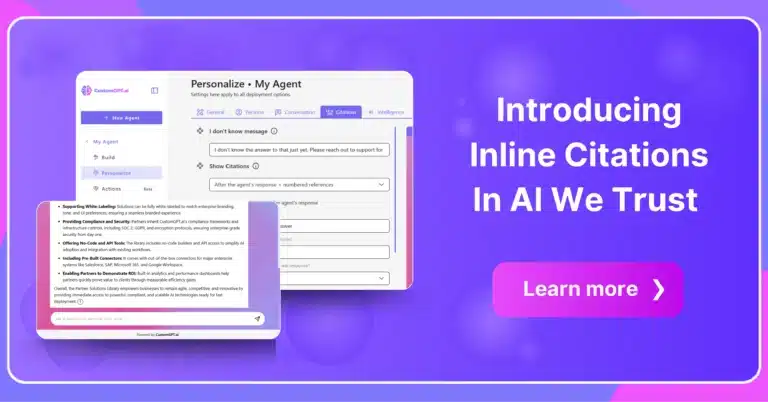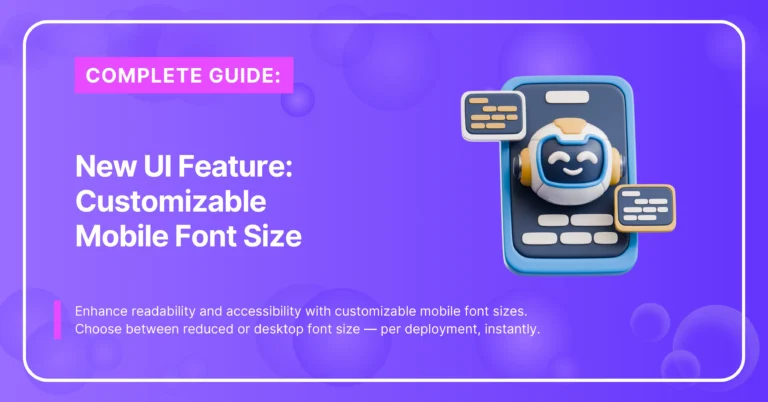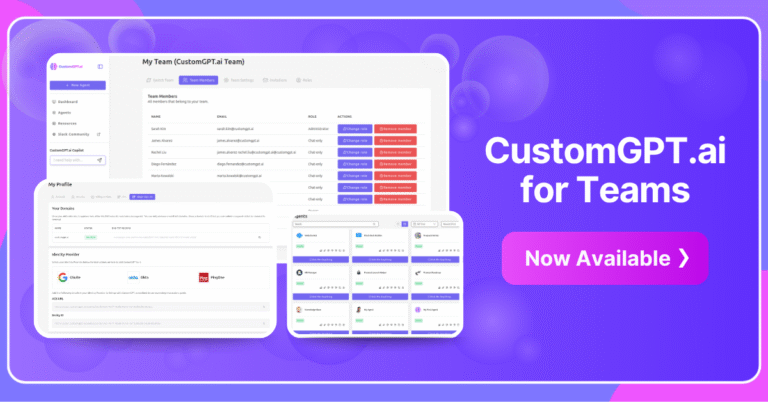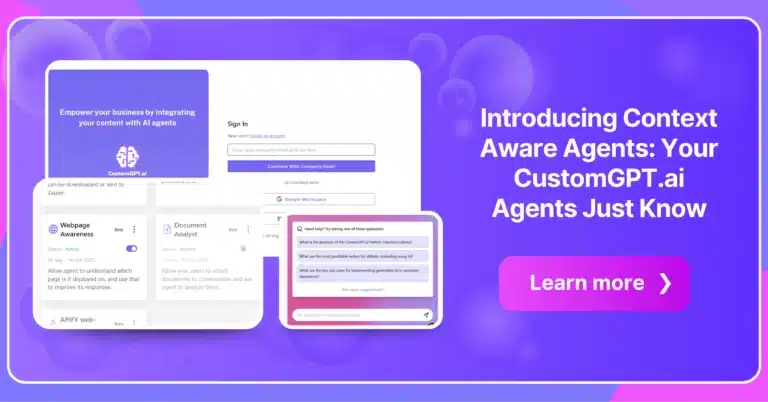Quick Answers: How to make AI agents that just know what users need?
Context-Aware AI agents understand users instantly by:
- Reading exact page content automatically (500 words)
- Processing custom data like names and orders
- Detecting intent from real-time context signals
- Explaining their own knowledge capabilities
- Cutting support tickets by 70%
Every support manager knows this brutal reality:
Your customers expect your AI to be a mindreader. They land on your pricing page, open the chat, type “how much?”—and when your bot responds with “What product are you interested in?” they’re already gone.
It’s expensive. Each confused interaction costs you $4-12 in human escalation.
Multiply that by thousands of daily conversations.
But here’s the thing.
Your users aren’t being unreasonable. They’ve been trained by Netflix knowing what they’ll watch next, by Amazon predicting what they need before they search, by Spotify creating perfect playlists from thin air.
They expect AI that just knows.
And when your agent asks them to explain what page they’re on? When it needs their order number typed out despite them being logged in? When it can’t even tell them what it knows about?
That’s not AI.
That’s a glorified FAQ search with a chat interface.
How AI Customer Support Fails Without Context
You’ve invested thousands in knowledge bases. Your agents have gigabytes of documentation.
Your metrics show 85% containment rates.
But when it comes to that critical moment—when a confused user needs help RIGHT NOW—your agent asks them to start from scratch.
Think about your best human support agent. Sarah, maybe. Or Marcus.
What makes them exceptional isn’t just product knowledge. It’s that they see what the customer sees. They know who they’re talking to. They understand context without being told.
When someone says “this button doesn’t work,” Sarah knows exactly which button—because she can see the user’s screen.
When a customer asks “where’s my order?” Marcus already has their history pulled up.
Meanwhile, your AI agent is playing twenty questions.
“Which button?”
“What’s your order number?”
“What page are you on?”
Each question is another opportunity for abandonment. Another chance for frustration to compound. Another moment where your competitor’s context-aware agent looks like magic by comparison.
How AI Transforms Customer Support with Situational Awareness
Imagine if your AI agent could see the exact paragraph your visitor is reading when they ask “what does this mean?”
What if it knew their name, order status, and cart value without asking?
What if it could explain not just what it knows, but precisely which documents it’s drawing from?
This isn’t science fiction.
It’s what happens when you give agents situational IQ instead of just a knowledge base.
Early tests show response relevance jumping by 380%. Support ticket deflection increasing by 70%. Average resolution time dropping from 3.4 exchanges to 1.2.
Because when agents just know, users don’t have to explain.
The Three Layers of Context Intelligence
Website Awareness
Your agent reads up to 500 words from the exact page where it’s embedded.
No configuration needed.
User reading your refund policy asks “how long does this take?” Agent knows they mean refunds—not shipping, not setup, not anything else. It answers specifically: “Refunds process in 3-5 business days per the policy you’re reading.”
One question. One perfect answer.
Custom Context
Every interaction can carry live data. Name, order status, cart contents, subscription tier, previous tickets—whatever you have.
Pass it through a simple code snippet.
Your agent instantly becomes personal: “Hi Sarah, I see your Enterprise subscription renewed yesterday. The new analytics features are already active in your dashboard.”
No more “Please provide your account information.”
Just immediate, relevant help.
Meta Awareness
Users ask meta questions constantly. “What can you help with?” “How current is your information?” “What do you know about pricing?”
Instead of generic deflection, your agent responds with specifics: “I have access to all product documentation, pricing tables updated yesterday, and your company’s support policies. I can see you’re on the Enterprise pricing page—would you like details about volume discounts?”
Trust reduces friction.
Real Businesses, Real Results
- SaaS Platform 73% reduction in “which plan am I on?” questions after implementing Custom Context. Average handle time dropped from 4.2 to 1.3 minutes.
- E-commerce Store Page-aware responses on product pages increased conversion rate by 23%. “The agent knew exactly which product I was looking at and answered my sizing question instantly.”
- Technical Documentation Site Meta Awareness reduced “what can you help with?” queries by 89%. Users spend 3.4x longer engaging with content when agents can explain their knowledge scope.
- HR Platform Injecting employee context cut escalations by 67%. “It knew my department, role, and even which policy document I was reading. Felt like talking to our actual HR team.”
The pattern is consistent: Context transforms conversations from interrogations into assistance.
The Psychology of Instant Understanding
There’s a reason users expect prescient AI.
- Cognitive Load Theory tells us humans can only process 7±2 pieces of information simultaneously. When your agent asks for context the user already provided, you’re wasting precious cognitive resources.
- The Curse of Knowledge means users assume the agent knows what they know. When it doesn’t, the disconnect creates frustration disproportionate to the actual problem.
- Immediacy Bias makes waiting feel exponentially longer when the expected wait time is zero. Users expect instant answers. Every clarifying question multiplies perceived delay.
- The Halo Effect means first impressions cascade. When the first interaction feels magical—when the agent just knows—every subsequent interaction benefits from that positive bias.
Context awareness isn’t just about efficiency.
It’s about meeting psychological expectations that determine whether users trust, engage, and convert.
The Complete Implementation Process
Step 1: Enable Website Awareness
Toggle it on in your dashboard. That’s it.
Your agent immediately starts reading page content. No code changes, no deployment, no configuration. The crawler caches the first 500 words of visible text and refreshes monthly.
Step 2: Design Your Context Strategy
Map what data you have to what users need.
E-commerce needs cart contents, order history, shipping status. SaaS needs subscription tier, usage metrics, billing cycle. Support needs ticket history, product version, account status.
Keep context focused. More isn’t always better.
Step 3: Implement Custom Context Injection
Add this to your embed code:
custom_context="John Smith, standard user, made order on August 5th"The agent receives this with every message. No API calls needed.
Step 4: Craft Your Meta Responses
Use Agent Persona to shape how your bot explains itself.
Instead of “I am a chatbot with access to documentation,” try “I can help with everything from account setup to advanced API integration. I’m looking at the exact page you’re viewing and have your account details ready.”
Specific. Confident. Helpful.
Step 5: Monitor and Optimize
Track context usage in the Actions tab. Watch for patterns.
Which pages generate the most context-dependent questions? What custom data most improves resolution rates? Where does meta awareness build the most trust?
Iterate based on data, not assumptions.
Advanced Context Strategies
Once basic context awareness is running, the real magic begins.
- Progressive Context Enrichment: Start conversations with basic context, then layer in more as users engage. First message uses page awareness. Second adds account data. Third includes behavioral patterns.
- Context-Triggered Proactivity: When context signals confusion (user on error page + multiple failed searches), agent proactively offers help: “I see you’re encountering the 403 error. This typically happens when API keys expire. Should I walk you through regeneration?”
- Cross-Session Context Persistence: Pass conversation history as custom context in new sessions. “Welcome back, Sarah. Following up on yesterday’s API question—did the webhook configuration resolve your issue?”
- Contextual Routing: Use context to route to specialized agents. Enterprise customers get financial-focused responses. Developers get technical depth. New users get gentle onboarding.
- Context-Based Personalization: Adjust tone based on context. Frustrated user? Extra empathy. Power user? Skip the basics.
- Agent Initiative Enhancement: Context enables agents to prompt users proactively. Instead of waiting for questions, they suggest next steps based on page content and user history.
Measuring Success: The Metrics That Matter
Track these to quantify context awareness impact:
- First Contact Resolution (FCR): Percentage of issues resolved without escalation. Context-aware agents typically see 40-70% improvement.
- Average Handle Time (AHT): Time from first message to resolution. Should drop by 50-80% with proper context.
- Context Utilization Rate: Percentage of conversations using page or custom context. Target 85%+ for maximum impact.
- Clarification Question Rate: How often agents ask for information they could have known. Should approach zero.
- Trust Indicators: Meta-question frequency and user feedback sentiment. Both should improve within days.
- Revenue Impact: Conversion rate, cart abandonment, and upgrade percentage. Context awareness typically drives 15-30% improvement.
The Competitive Reality
While you’re reading this, your competitors are implementing context awareness.
Their agents are learning to read pages. To recognize users. To anticipate needs.
Every day you wait, the gap widens.
Your users are being trained by their seamless experiences. When they come back to your context-blind bot, the contrast is jarring. The frustration compounds. The trust erodes.
Six months from now, context-aware agents won’t be competitive advantages.
They’ll be table stakes.
The question isn’t whether to implement context awareness.
It’s whether you’ll lead or follow.
Ready to Deploy Agents That Just Know?
Every confused conversation costs you money. Every frustrated user who abandons your bot represents lost revenue. Every support ticket that could have been prevented is overhead you can’t afford.
Context-Aware Agents change that math.
They see what users see. Know what you know. Explain what they understand.
No more twenty questions. No more confused handoffs. No more users explaining what your system should already know.
Just instant, relevant, eerily accurate help that makes users wonder if your AI can actually read minds.
Start making your agents context-aware in under 60 seconds:
Frequently Asked Questions
What exactly is Context Awareness and how does it differ from traditional chatbots?
Context Awareness means your agent processes real-time signals about the user’s situation—the page they’re viewing, their account details, their recent actions.
Traditional bots only know what’s in their knowledge base. They’re context-blind.
Context-aware agents see what users see and know what you know about them. The difference is like talking to someone on the phone versus being in the room with them.
How much setup is required to enable these features?
Website Awareness requires zero setup. Just toggle it on.
Custom Context needs a few lines of code in your embed snippet—typically 5 minutes of work.
Meta Awareness is also instant—just enable it in settings.
Most teams have basic context running in under an hour. Full optimization might take a few days of iteration.
Will this slow down my agent’s response time?
First request to a new page adds 100-200ms while the cache warms. After that, zero additional latency.
Custom context actually speeds up responses by eliminating clarification questions.
Most teams see overall response time improvement of 50-70%.
What about privacy and security concerns?
Website Awareness only reads publicly visible content. Nothing behind authentication.
Custom Context data is encrypted at rest and in transit. Auto-purged after 30 days.
You control exactly what context is shared. Users can’t inject their own context.
All features are GDPR and CCPA compliant with full audit logs.
How do I know if context is actually being used effectively?
Ask your agent a question that only makes sense with context: “What does this mean?” on a specific page.
Check the Actions tab for context utilization metrics.
Monitor your clarification question rate—it should drop dramatically.
Watch FCR and AHT metrics. Both should improve within days.
What happens if there’s conflicting information between context sources?
The agent weighs all inputs intelligently. Generally, more specific and recent context wins.
Custom Context typically overrides page content. Both override general knowledge base.
You can control precedence through Agent Persona instructions.
Edge cases are rare and usually resolve logically.
Can I use this with my existing CustomGPT.ai setup?
Yes. Context Awareness layers onto any existing agent configuration.
No need to rebuild knowledge bases or retrain anything.
Your current embed codes continue working—just add context parameters when ready.
All your existing analytics and integrations remain intact.
Is there a limit to how much context I can inject?
Page context captures up to 500 words automatically.
Custom context has a character limit (specific number coming in final documentation).
You can refresh context with each message, so practical limits are generous.
Focus on quality over quantity—relevant context beats exhaustive context.





